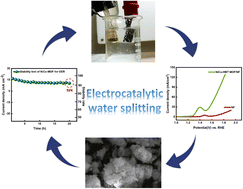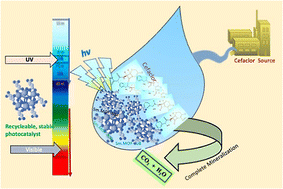
RSC Advances
Subject area
Organic materials articles published in the last
6 months

An ambipolar PEDOT-perfluorinated porphyrin electropolymer: application as an active material in energy storage systems
Development of a new n-p polymer based on the electropolymerization of a dual-functional porphyrin-EDOT monomer. The ambipolar polymeric material showed promising pseudocapacitive behavior for energy storage devices.

RSC Adv., 2024,14, 15929-15941
https://doi.org/10.1039/D4RA00945B
LiCl in situ decorated metal–organic framework (MOF)-derived porous carbon for efficient solar-driven atmospheric water harvesting
LiCl in situ decorated MOF-derived porous carbon sorbents (PCl-4) were prepared from Li-MOFs for atmospheric water harvesting. PCl-4 displays excellent water-capture capabilities and efficient solar-driven water release with nice recyclability.

RSC Adv., 2024,14, 15619-15626
https://doi.org/10.1039/D4RA02364A
MOF-modified dendrite-free gel polymer electrolyte for zinc-ion batteries
Zinc-ion batteries are promising candidates for large-scale energy storage, and gel polymer electrolytes (GPEs) play an important role in zinc-ion battery applications.

RSC Adv., 2024,14, 15337-15346
https://doi.org/10.1039/D4RA02200A
Investigation of the photocatalytic activity of magnetically recoverable g-C3N4/CoFe2O4/Bi2MoO6 particles for purifying tetracycline antibiotics: synthesis, characterization, ecotoxicity analysis, and plant toxicity test
To purify water polluted by tetracycline antibiotics, a new visible light-driven magnetically recoverable photocatalyst, g-C3N4/CoFe2O4/Bi2MoO6, was prepared in this study, and it effectively removed tetracycline antibiotics.

RSC Adv., 2024,14, 15302-15318
https://doi.org/10.1039/D4RA01593B
Fabrication of bulk superhydrophobic wood by grafting porous poly(divinylbenzene) to wood structure using isocyanatoethyl methacrylate
Robust bulk superhydrophobic wood with super abrasion resistance was prepared using graft copolymerization and solvothermal methods.

RSC Adv., 2024,14, 15201-15208
https://doi.org/10.1039/D4RA00889H
Effect of calcination temperature induced structural modifications on the photocatalytic efficacy of Fe2O3–ZrO2 nanostructures: mechanochemical synthesis
Water contamination due to organic pollutants is a challenging issue around the globe, and several attempts have been made to deal with this issue.

RSC Adv., 2024,14, 15085-15094
https://doi.org/10.1039/D4RA01944J
The stability of CsPb(BrxCl1−x)3 all-inorganic mixed halide perovskites
From the perspective of configuration characteristics (octahedra types, distortion, and order–disorder), the stability of all-inorganic mixed halide perovskites (CsPb(BrxCl1−x)3) is studied.

RSC Adv., 2024,14, 14894-14903
https://doi.org/10.1039/D4RA00818A
Effective separation of dyes/salts by sulfonated covalent organic framework membranes based on phenolamine network conditioning
This study developed a modified polyacrylonitrile (PAN) membrane controlled by a phenol–amine network and enhanced with a sulfonated covalent organic framework (SCOF), aimed at improving the efficiency of textile wastewater treatment.

RSC Adv., 2024,14, 14593-14605
https://doi.org/10.1039/D4RA01736F
Advanced photocatalytic materials based degradation of micropollutants and their use in hydrogen production – a review
The future directions of photocatalytic degradation of micropollutants (pharmaceuticals, dyes, pesticides, etc.) and its role in green fuel production from wastewater are discussed with several examples of modern photocatalysts.

RSC Adv., 2024,14, 14392-14424
https://doi.org/10.1039/D4RA01307G
Upcycling of sugar refining mud solid waste as a novel adsorbent for removing methylene blue and Congo red from wastewater
The feasibility of utilizing the mud solid waste produced during sugar refining as a cost-effective and environmentally friendly alternative for the removal of methylene blue and Congo red from wastewater is presented.

RSC Adv., 2024,14, 13505-13520
https://doi.org/10.1039/D4RA01451K
MOF/graphene oxide based composites in smart supercapacitors: a comprehensive review on the electrochemical evaluation and material development for advanced energy storage devices
Driving towards sustainable energy solutions: harnessing metal–organic framework/graphene oxide composites to propel high-efficiency smart supercapacitors.

RSC Adv., 2024,14, 14311-14339
https://doi.org/10.1039/D4RA01027B
High-performance self-powered ultraviolet photodetector based on a ZnO/CuPc inorganic/organic heterojunction
Device structure and carrier behavior.

RSC Adv., 2024,14, 13361-13366
https://doi.org/10.1039/D4RA01773K
A review on MOFs synthesis and effect of their structural characteristics for hydrogen adsorption
Climate change is causing a rise in the need to transition from fossil fuels to renewable and clean energy such as hydrogen as a sustainable energy source.

RSC Adv., 2024,14, 14233-14253
https://doi.org/10.1039/D4RA00865K
Elucidating the performance of hexamethylene tetra-amine interlinked bimetallic NiCo-MOF for efficient electrochemical hydrogen and oxygen evolution
This study investigates the electrocatalytic water splitting capabilities of hexamethylene tetra-amine-linked NiCo-MOF, synthesized via hydrothermal approach. It reveals low overpotentials of 274 mV and 330 mV with Tafel slopes of 78 mV dec−1 and 86 mV dec−1 towards HER and OER respectively.

RSC Adv., 2024,14, 13837-13849
https://doi.org/10.1039/D4RA00340C
The influence of hydrogen bonding on the structure of organic–inorganic hybrid catalysts and its application in the solvent-free epoxidation of α-olefins
Different reaction routes with the influence of hydrogen bonding and without hydrogen bonding.

RSC Adv., 2024,14, 12853-12863
https://doi.org/10.1039/D4RA01399A
Current status of controlled onco-therapies based on metal organic frameworks
Most MOFs for controllable cancer treatment act as drug delivery vehicle and/or anti-cancer agent. Molecules with anti-cancer roles such as chemotherapies, gases, peptides or nucleic acids can be loaded into MOFs that decompose in cancer cells or in the TME to release its cargoes.

RSC Adv., 2024,14, 12817-12828
https://doi.org/10.1039/D4RA00375F
Insoluble low-impedance organic battery cathode enabled by graphite grafting towards potassium storage
Insoluble polymerized organic electrode is developed and wrapped in graphite sheets, which possesses low-impedance and realized a cycling life of over 1500 cycles. This work provides insights for exploring high-performance organic cathodes.

RSC Adv., 2024,14, 12658-12664
https://doi.org/10.1039/D4RA01420K
Reusable magnetic mixture of CuFe2O4–Fe2O3 and TiO2 for photocatalytic degradation of pesticides in water
Mixture of TiO2-P25 and magnetic CuFe2O4–Fe2O3 nanocomposites improves photocatalytic water treatment and enables easy catalyst recovery, effectively degrading pollutants like 2,4-D.

RSC Adv., 2024,14, 12337-12348
https://doi.org/10.1039/D4RA00094C
Electric-field modulated energy transfer in phosphorescent material- and fluorescent material-codoped polymer light-emitting diodes
In this study, we find electric-field modulated energy transfer in phosphorescent material- and fluorescent material-codoped polymer that has never been reported.

RSC Adv., 2024,14, 12294-12302
https://doi.org/10.1039/D4RA00669K
Effect of fluorine on the photovoltaic properties of 2,1,3-benzothiadiazole-based alternating conjugated polymers by changing the position and number of fluorine atoms
Incorporation of fluorine atoms in conjugated polymers leads to an increase in charge mobility and dielectric constant, increasing the Pdiss value and power conversion efficiency and open circuit voltage of polymer bulk heterojunction photovoltaic cells.

RSC Adv., 2024,14, 11659-11667
https://doi.org/10.1039/D4RA01104J
In situ growth of Bi-MOF on cotton fabrics via ultrasonic synthesis strategy for recyclable photocatalytic textiles
CAU-17 was in situ grown on carboxymethylated cotton fabric by ultrasonication and exhibited favorable photocatalytic degradation ability.

RSC Adv., 2024,14, 11513-11523
https://doi.org/10.1039/D4RA00493K
Regioisomeric thieno[3,4-d]thiazole-based A-Q-D-Q-A-type NIR acceptors for efficient non-fullerene organic solar cells
With better phase separation in film morphology, regioisomeric non-fullerene acceptor TzS-S shows 1.5 times higher PCE and 20 times greater electron mobilities than TzN-S, indicating the role of isomeric conformations in photovoltaic performance.
![Graphical abstract: Regioisomeric thieno[3,4-d]thiazole-based A-Q-D-Q-A-type NIR acceptors for efficient non-fullerene organic solar cells](/en/Image/Get?imageInfo.ImageType=GA&imageInfo.ImageIdentifier.ManuscriptID=D4RA01513D&imageInfo.ImageIdentifier.Year=2024)
RSC Adv., 2024,14, 10969-10977
https://doi.org/10.1039/D4RA01513D
Fabrication of samarium doped MOF-808 as an efficient photocatalyst for the removal of the drug cefaclor from water
MOFs are emerging photocatalysts designed by tuning organic ligands and metal centers for optimal efficiency.

RSC Adv., 2024,14, 10736-10748
https://doi.org/10.1039/D4RA00914B
One-pot in situ synthesis of an NS-ligand co-doped metal–organic framework for the enhanced adsorption-assisted photocatalytic decontamination of metronidazole
In this study, an in situ synthesis approach is employed for the co-doping of an NS ligand into PCN-600. The resulting PCN-600-NS is explored for the photocatalytic degradation of the antibiotic metronidazole (MTZ).

RSC Adv., 2024,14, 10229-10243
https://doi.org/10.1039/D4RA00812J
Controllable fabrication of CoNi bimetallic alloy for high-performance electromagnetic wave absorption
With the coming era of artificial intelligence (AI) dominated by high-tech electronics, developing high-performance microwave absorption materials (MAMs) is imperative to solve the problem of increasing electromagnetic inference and pollution.

RSC Adv., 2024,14, 9791-9797
https://doi.org/10.1039/D3RA08896K
Browse by Subject
- All (342 articles)
- Atomic/elemental (14 articles)
- Bioanalytical (66 articles)
- Chemometrics (30 articles)
- Crystallography (165 articles)
- Electroanalytical (54 articles)
- Imaging/microscopy (33 articles)
- Mass spectrometry (22 articles)
- Medical diagnostics (80 articles)
- Microfluidics (18 articles)
- Nanoanalysis (21 articles)
- Separation science (28 articles)
- Spectroscopy (97 articles)
- All (283 articles)
- Bioinorganic chemistry (51 articles)
- Bioorganic chemistry (27 articles)
- Biotechnology (54 articles)
- Cellular chemistry (57 articles)
- Computational (83 articles)
- Drug delivery (81 articles)
- Drug discovery (187 articles)
- Imaging/diagnostics (16 articles)
- Molecular biology (6 articles)
- Nanotechnology (45 articles)
- Natural products (29 articles)
- Pharmacology (89 articles)
- Photobiology (15 articles)
- Polymorphism (pharma) (1 article)
- Structural biology (15 articles)
- Toxicology (5 articles)
- All (567 articles)
- Biomaterials (106 articles)
- Biopolymers (103 articles)
- Carbon materials (102 articles)
- Composites (254 articles)
- Electronic materials (97 articles)
- Encapsulation (1 article)
- Energy applications (87 articles)
- Films/membranes (82 articles)
- Gels & soft matter (35 articles)
- Inorganic materials (50 articles)
- Medical materials (72 articles)
- Nanomaterials (121 articles)
- Optical materials (54 articles)
- Organic materials (62 articles)
- Polymers (140 articles)
- All (356 articles)
- Assembly (13 articles)
- Biotechnology (32 articles)
- Carbon nanomaterials (80 articles)
- Imaging/microscopy (18 articles)
- Nanoanalysis (42 articles)
- Nanocatalysis (32 articles)
- Nanomaterials (217 articles)
- Nanomedicine (46 articles)
- Nanotoxicology (58 articles)
- Optical nanomaterials (38 articles)
- Synthesis (13 articles)
- All (177 articles)
- Bioorganic (17 articles)
- Catalysis (48 articles)
- Fine chemicals (25 articles)
- Natural products (21 articles)
- Physical organic (7 articles)
- Stereochemistry (12 articles)
- Supramolecular (3 articles)
- Sustainable synthesis (35 articles)
- Synthetic methodology (106 articles)
- Total synthesis (12 articles)
- All (321 articles)
- Biophysics (3 articles)
- Charge transfer (31 articles)
- Electrochemistry (12 articles)
- Energy research (18 articles)
- Imaging/microscopy (5 articles)
- Kinetics & dynamics (40 articles)
- Materials (108 articles)
- Mechanics (35 articles)
- Nanoscience (72 articles)
- Photoscience (25 articles)
- Quantum & theoretical (88 articles)
- Simulations (25 articles)
- Single molecules (43 articles)
- Soft matter (5 articles)
- Spectroscopy (7 articles)
- Surfaces & interfaces (69 articles)